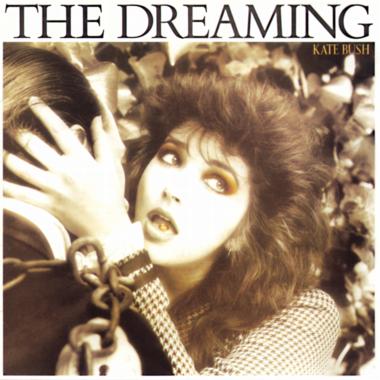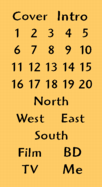© John Carder Bush/Kindlight and Nick Price for the album cover.
© Kate Bush/EMI for the music (excerpt).
© Per A.J. Andersson for the text. Written April 2004, updated September 2014.

The
Dreaming
by Kate Bush
|
She was one of the most successful new female acts of the day. And the most photographed woman in Britain. Then she threw it all away (at least that's what people said). Kate Bush really went her own way – more than once. — • — Catherine Bush came to this world on 30th July 1958. She was born and raised in semi-urban surroundings in north London, her father being a doctor and her mother a former nurse. As the youngest child with two elder brothers to look up to and fight with, "Cathy" (as she was soon to be called) was brought up, being influenced by the orientalism and off-beat antics of "Paddy" (Patrick) and the more more intellectual approach of oldest brother "Jay" (John Carder) . Cathy was a protected child, spending a lot of time with the family, who nevertheless favoured a free upbringing. Here she was able to make a place for herself and gaining respect as an individual. The domestic culture soon showed, as the young Catherine developed a taste for writing free-ranging, fantastical poems and strumming away at an old organ sitting in the barn at the back of the house. In her early teens Cathy started to write her own, simple but beautiful compositions, bringing them to life playing the piano. And using her unusually flexible voice, often sung in a keening way. Her talents lyrics-wise were also apparent, as books, people in faraway places and sensitive situations were dealt with in a highly mature and emotional way, presenting a scope of material beyond her years. — • — A friend of the family heard of the musical talent of young Catherine, and through him a demo tape reached the ears of David Gilmour of Pink Floyd fame. The year was 1973. He was equally astounded by this talented young girl, and ultimately (two gruelling years later) things ended up with EMI signing a recording contract with her. EMI, however, understood that this young artist was far from ready for the big scene, so she was given a handsome allowance and time to develop further. Kate spent part of the time practicing dance and voice. During the summer of 1977 she performed at local clubs in the London area as part of the KT Bush Band. This was a group originally put together by her brother Paddy and a couple of his friends. Then EMI decided their young protegé was ready, and recordings of Kate's first album started at the end of summer. At the sessions Kate was joined by the members of the KT Bush Band (bass-player Del Palmer would eventually become Kate's long-lasting partner off-stage as well). People from the pop groups Cockney Rebel and Pilot completed the array of musicians. Production lay in the hands of Andrew Powell, a well-known name to David Gilmour and already involved with Kate's earliest EMI recordings in 1975. — • — But Kate Bush was the natural centre of attention. She presented a whole book of compositions written since her early teens, which only called for proper arrangements. Of the lot 13 tracks survived onto the finished album, among them Kate's own choice for the debut single - "Wuthering Heights". Being a melodramatic song and filled with high notes and a literary background (based on Emily Brontë's novel), this was a thing likely to get people's attention. But it could also label her as a one-hit wonder. EMI finally agreed with Kate's choice, and in the following, the sheer diversity and melodic character of the other songs on the album proved them right. At the beginning of January the song hit the airwaves, and Kate Bush became an overnight sensation. Both the single and the accompanying album began to climb the charts (ending at numbers one and three respectively). She was already being touted as the new star of the EMI artist stable, as a bright young artist, singing remarkably well and being exceptionally pretty to boot. Kate's good looks helped her quickly gaining a place in the limelight. EMI felt the need to cash in on their new success-story, and a follow-up album was hastily produced. "Lionheart" was released in late 1978 to considerably lower sales. Then the Kate Bush Tour rolled out over Europe in the Spring of 1979. This tour extravaganza featuring lots of theatrics and costume changes, was an exhausting experience for everyone involved, and financially it was a disaster. Despite this, it (Kate's only tour to date!) further established Kate Bush as an artist to take note of. — • — In 1980 the beautifully conceived "Never for Ever" followed, with a varied mix of ballads and semi-instrumental sound experiments in the now familiar Kate Bush vein. The success of this album proved this was still a viable commercial artist in touch with the general audience, despite the eccentric and often demanding character of her pop songs. Then she disappeared. For two years nothing was heard of Kate Bush. And witnessing what eventually came out of this silence, in the eyes of the EMI executives she literally destroyed her career. To Kate herself it was about developing as an artist, discovering other facets of creating music. In the process she was also taking control of her own production (using her new home-based studio). The resulting album perplexed both her audience and the critics. The dense production and complex soundscapes of "The Dreaming" left little place for any easy-listening. The record company didn't know how to market such an ambitious production, and the album bombed in the marketplace. This was not "The Queen of Ethereal Pop" (People Magazine) people were used to. — • — Despite this, many Kate Bush fans still believe this was her finest hour (yet). The ten songs created each one a little world of its own, as both the music and the lyrics featured clearly different experimentations. Music-wise, Kate Bush went further down the technical road, leaving the critics complaining over an "over-produced album". She made extensive use of digitised sounds through the Fairlight, a digital sound sampling machine already in by musical friend and colleague Peter Gabriel. As for the lyrics, they dealt with... •
someone believing himself to be a king (Sat in Your Lap) Again Kate Bush went silent, licking her wounds and contemplating the lack of understanding for her new music. Another three years passed before the release of her next album. This time, it seems she had listened to some of the critis, as the sound on "Hounds of Love" showed a distinct elegance and clarity. The album also contained a huge hit, the energetic and danceable "Running up that Hill". Finally she was being noted State-side, as the song and the album finally hit the US charts. Nevertheless the ambitious sound experiments were still present, with the entire B side of the LP presented as "The Ninth Wave". — • — But the story was to repeat itself. EMI's young star had clearly matured into a highly challenging artist, demanding more and more out of herself to be able to release a record. Any momentum she had gained with "Hounds of Love" was long since gone by the time "The Sensual World" was released (1989). This time most notably Bulgarian choirs were added to the sound mix. And in 1993 came "The Red Shoes", the last album by Kate Bush to date. Despite a lot of talk about an up-coming album, nothing has materialised so far (April of 2004). The only thing for certain is Kate Bush in the meantime has become a mother of "Bertie" - born as Albert (father is guitarist Danny McIntosh). With or without a new CD Kate Bush has nevertheless produced a body of music more influential than most artists releasing far more than seven albums. She herself took inspiration from people like Pink Floyd and David Bowie. Like Joni Mitchell paved way for a generation of female singer-songwriters, Kate Bush formed an example for creative female artists world-wide. American Tori Amos and Polish Justyna Steczkowska are but two of the artists following suit. — • — There are still a lot of Kate Bush fans around - not the least on the Internet, where people discuss her life and music over a decade since her latest release. As Kate puts it herself, in Q Magazine (where the first interview with her for over seven years was published in November 2004): "If I'm really honest what I find so exciting is that people want to listen to my music when I'm not thrust in their faces. In this fast-moving world, people do forget, but they're incredibly patient with me." // — • — PS. Updates of 2007/2014: She really came back! Late 2005 Kate Bush released her first album in twelve years. A double CD, the album let us all know she can still make quirky, strange and unbelievably beautiful music. Now with an added touch from her experiences of being a mother. And in 2014 she is even touring! |
|
THE
DREAMING |
• Aerial (2005) |

